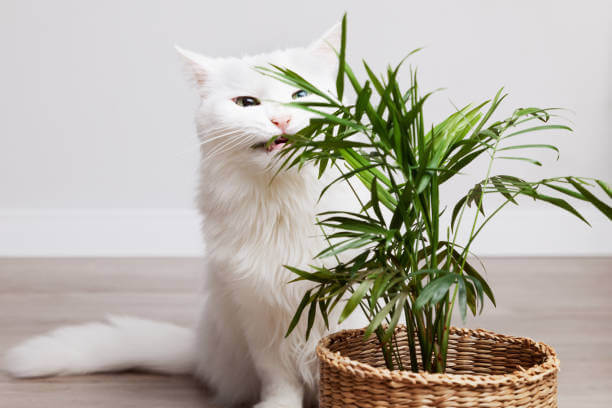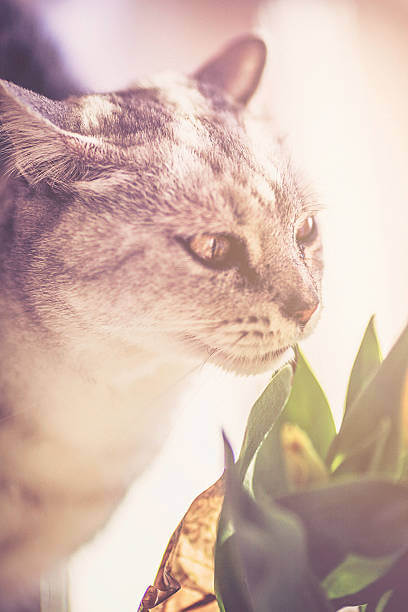Worried about your cat’s safety around plants? Find out if angel plants poisonous to cats and get advice on protecting them in this informative article. Cats bring a sense of joy, companionship, and mischief into our lives. One aspect of keeping our feline friends safe involves being aware of potential hazards within our homes, including the plants we choose to decorate with.
Angel plants, known for their elegance and delicate beauty, have become popular among plant enthusiasts. However, when it comes to our furry friends, are angel plants poisonous to cats? In this article, we will explore this question in detail and provide you with valuable insights on keeping your cat safe around these botanical wonders.
Understanding Plants Poisonous to Cats

Before delving into whether angel plants are toxic to cats or not, let’s familiarize ourselves with these captivating houseplants. Angel plants belong to the Araceae family and are scientifically known as Caladium species. Renowned for their striking foliage patterns and vibrant colors, they add an artistic touch to any indoor space. The leaves of angel plants can be heart-shaped or arrow-shaped, showcasing hues ranging from green and white to pink and red.
Potential Toxicity of Angel Plants
While the allure of angel plants is undeniable, it is essential to recognize that some varieties may pose a threat to our beloved feline companions. The leaves of angel plants contain calcium oxalate crystals that are toxic when ingested by cats or other animals. These crystals can cause various symptoms such as oral irritation, drooling, difficulty swallowing, vomiting, and even respiratory distress in severe cases.
What Are Exotic Angel Plants?
In addition to the traditional angel plant species, there are also exotic varieties available in the market. These plants have an even more eye-catching foliage pattern and a richer range of colors compared to the standard angel plants. Unfortunately, these exotic varieties also contain a much higher concentration of calcium oxalate crystals, making them more hazardous to cats.
Varieties of Angel Plants
It is worth noting that different species within the Caladium genus have varying levels of toxicity. Some common types include:
- Caladium bicolor: This variety features heart-shaped leaves with vibrant patterns in shades of green, white, pink, or red.
- Caladium hortulanum: Also known as “fancy-leaved caladium,” this species boasts large, arrow-shaped leaves with intricate patterns and contrasting colors.
- Caladium x hortulanum: A hybrid of different Caladium species, this type exhibits a mix of characteristics from its parent plants.
- Caladium picturatum: With its elongated, lance-shaped leaves and prominent veining, this variety adds a touch of elegance to any setting.
Signs of Poisoning in Cats
It is crucial to be aware of the signs that may indicate your cat has ingested or come into contact with a toxic plant like an angel plant. Some common symptoms include:
- Excessive drooling
- Pawing at the mouth or face
- Vomiting
- Difficulty swallowing
- Swelling or redness of the mouth, tongue, or lips
If you notice any of these signs or suspect your cat has had contact with an angel plant, it is essential to seek veterinary attention promptly.
Keeping Your Cat Safe Around Angel Plants

While certain types of angel plants may be toxic to cats, there are steps you can take to ensure your feline friend’s safety while still enjoying the beauty of these plants in your home.
1. Choose Non-Toxic Alternatives
Consider opting for cat-friendly houseplants instead. There are numerous non-toxic options available that can enhance your living space without posing a risk to your furry companion. Spider plants (Chlorophytum comosum), Boston ferns (Nephrolepis exaltata), and Areca palms (Dypsis lutescens) are just a few examples of cat-safe alternatives that offer aesthetic appeal.
2. Create Physical Barriers
To prevent access to angel plants altogether, consider placing them in areas that are inaccessible to your cat. High shelves or hanging baskets can serve as effective deterrents, ensuring your feline friend cannot reach the plants.
3. Train and Distract
Training your cat to stay away from certain areas or objects can be beneficial. Use positive reinforcement techniques, such as treats or toys, to redirect their attention to more appropriate play areas.
4. Monitor Indoor Plants
Be diligent in removing fallen leaves or plant parts that may attract your cat’s curiosity.
5. Educate Yourself
Stay informed about the potential hazards associated with various houseplants. Research and identify any new additions to your indoor garden to ensure they are safe for your cat.
By following these precautions, you can create a safe environment for your cat while still enjoying the beauty of plants within your home.
Common Exotic Angel Plants That Are Not Poisonous to Cats
Some exotic angel plant varieties are safe for cats, including the following:
- Caladium Candidum: Also known as “White Wing,” this type features large arrow-shaped leaves with striking white and green veins. It is non-toxic to cats and other pets.
- Caladium Sumatranum: With its intricate network of pink and green veins, this species adds a dash of color to any home. It is also non-toxic to cats and other animals.
Caladium Sulphureum: This variety boasts soft yellow leaves accented with dark green veining. Its foliage is safe for cats and other pets.
FAQS
Q: Are angel plants toxic to cats?
A: Yes, some angel plant varieties can be toxic to cats when ingested or if they come into contact with the plant. Calcium oxalate crystals found in the leaves of these plants can cause various symptoms such as oral irritation, drooling, difficulty swallowing, vomiting and even respiratory distress in severe cases.
Q: Are there any safe angel plant varieties for cats?
A: Yes, some exotic angel plants are non-toxic to cats. Examples include Caladium Candidum, Caladium Sumatranum and Caladium Sulphureum. It is important to research any new additions to your home before bringing them in, as certain types can be very hazardous to cats .
Q: What should I do if my cat shows signs of poisoning?
A: If you notice any symptoms or suspect your cat has ingested a toxic plant, it is essential to seek veterinary attention immediately. Early detection and intervention can help minimize the risk of complications from plant poisoning.
Q: How can I keep my cat safe around angel plants?
A: With the right precautions, you can create a safe environment for your feline friend at home. Consider choosing non-toxic alternatives, creating physical barriers to restrict access, training and distracting your cat away from potential hazards, monitoring indoor plants regularly and educating yourself about the potential dangers of certain types of plants.
Conclusion
Angel plants are beautiful additions to any indoor garden, but they can be toxic to cats if ingested. To protect your furry friend, it is important to research any new plants you bring into your home and take the necessary precautions to ensure their safety. Non-toxic alternatives, physical barriers , training and distraction techniques, regular monitoring, and educating yourself about potential dangers can all help to keep your cat safe while still enjoying the beauty of these plants in your home.
This article is not intended as a substitute for professional veterinary advice, diagnosis or treatment. Always seek the advice of your veterinarian or other qualified professionals with any questions you may have regarding medical conditions affecting your pet. If you think your pet may have ingested any plant material, seek veterinary attention immediately.
